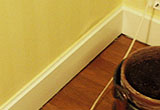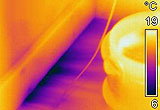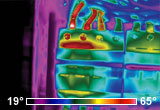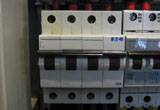Infrared Cameras for Building Diagnostics
Maintaining acceptable temperatures in building (heating and cooling) uses a large proportion of total energy consumption worldwide. When well insulated, a building:
- Is energy-efficient, thus saving the owner money
- Provides more uniform temperature throughout the space, thus producing a more comfortable occupant environment when outside temperatures are extremely cold or hot.
- Has minimal recurring expense. Unlike heating and cooling equipment, insulation is permanent and does not require maintenance, upkeep, or adjustment.
Infrared thermography is the easiest and quickest method to detect energy waste, moisture and electrical issues in buildings. An infrared camera shows exactly where the problems are and helps focus the inspectors’ attention allowing him or her to properly diagnose areas with energy loss.
Building Diagnostics

Poor or inadequate insulation, moisture, building envelope leaks, and substandard work are costly to residential and commercial building owners. An infrared camera can help you quickly see where energy efficiency can be improved.
Buildings may be quickly and thoroughly scanned using a FLIR thermal imager, identifying problem areas that can’t be seen by the naked eye.
FLIR cameras make it easy to improve energy efficiency and locate repairs with minimal disruption.
FLIR infrared cameras instantly show you what is wet and what is dry. IR cameras can help find the sources of trouble with minimal impact to people and buildings. FLIR infrared cameras are preferred by building experts for fast, reliable, accurate building diagnosis in the entire range of building problems.
In addition to the most advanced infrared cameras, FLIR offers building diagnostics training for a fast payback.
HVAC & Plumbing

A “whole building” approach is needed to maximize energy efficiency of a building or a home. Indoor environment can be compromised by poor insulation, poorly sealed windows and doors, inadequate or poorly sealed ductwork, plumbing leaks, or other plumbing issues relating to Heating Ventilation and Air Conditioning (HVAC) systems.
With FLIR thermal imagers it’s easy to scan an entire building to see the relation of HVAC system, building envelope, and plumbing issues.
An infrared camera is a practical tool that helps building professionals see the big picture. With FLIR infrared cameras for builders, it is easy to scan an entire building and see the relation of HVAC system, building envelope, and plumbing issues.
And, with FLIR cameras, you get advanced features to help you see how, when, and where energy saving solutions can be implemented. From determining insulation effectiveness to diagnosing faulty ductwork, a FLIR infrared camera helps protect your business from start of a job to completion.
Moisture & Restoration

The presence of moisture in building envelopes, either from leakage or condensation, can have serious consequences. With infrared images, water damage is easily detected.
Whether you need to restore property from moisture, mold, or fire damage, you know the value of having comprehensive and accurate information at your fingertips. Insurance companies need information fast to start claims work. Your customers need information so they can get their property restored. And you need information so you can make estimation and reporting trouble free.
FLIR infrared cameras can help you simplify your restoration and remediation jobs. Advanced features help you quickly scan large areas to assess what is restorable. An infrared camera helps you pinpoint water intrusion, find moisture beneath the surface, and document dryness with accuracy and confidence.
Easy Reporting
Busy restoration professionals can speed up surveys with the automated dew-point and humidity alarms. Reporting is also simple as a FLIR camera includes software that supports templates, spell-check, and easy conversion of reports and images to PDF format for trouble-free emailing.
Energy Auditing & Home Inspection

Excessive air leakage can account for up to half of the energy consumed to condition buildings. The leakage pathway is often complex and, without thermal imaging, extremely difficult to visualize.
Air Tightness and Thermal Imaging testing are important quality control measures when building or renovating a house. Heat losses in buildings can account for up to 50% of the total energy consumption and comes from air leakage through chimneys, attics, wall vents and badly sealed windows/doors, etc.

 Detection and Visualization of Air Infiltration and Exfiltration
Detection and Visualization of Air Infiltration and Exfiltration
Adequate air exchange is essential for the occupants’ health and safety, but most buildings have a far higher rate of air exchange than is necessary. The root cause is often poor design and/or construction which allows air leakage from the inside of outside of the building, or the opposite. The leakage pathway is often complex and, without thermal imaging, extremely difficult to visualize. This also allows the contractors to quickly identify and repair the problem areas to stop the energy loss immediately.
Improved Energy Efficiency
To identify areas of energy waste infrared imaging has quickly become a valued tool in identifying problems related to energy loss, missing insulation, inefficient HVAC systems, radiant heating, water damage on roofs, and much more. A thermal imaging camera identifies patterns of heat loss that are invisible to the naked eye. Thermal imaging will quickly indicate the air leaks within a property and measurement data are easily compiled into a report.
Professional home inspectors and energy auditors are using leading-edge infrared technology from FLIR to perform energy auditing of homes and buildings to improve energy efficiency, thus leading to savings on energy costs.
Property & Facility Management

Thermal imagers are a valuable tool in predictive maintenance of electrical, mechanical, and structural systems, to detect problems, prevent downtime, guide corrective action, and increase work safety.
Infrared thermography is a powerful & non-invasive method of monitoring and troubleshooting the conditions of buildings.
Infrared thermography operates by measuring the infrared energy of any objects surface and producing a detailed visual image showing its temperature profile. Since IR operates without physical contact, it gives building managers a safe, on-line, and cost effective means to evaluate a buildings operating integrity. While many borderline problem areas typically remain undetected during an off-line physical inspection, they can easily be seen using infrared.
Aside from detecting heat and energy loss in structures, it has proved to be an accurate & effective tool in today’s facilities predictive maintenance (PdM) programs.


FLIR Infrared Cameras for Maintenance Professionals
To identify areas of energy waste infrared imaging has quickly become a valued tool in identifying problems related to energy loss, missing insulation, inefficient HVAC systems, radiant heating, water damage on roofs, and much more. A thermal imaging camera identifies patterns of heat loss that are invisible to the naked eye. Thermal imaging will quickly indicate the air leaks within a property and measurement data are easily compiled into a report.
Technology improvements have driven costs down. As a result, the role of facilities maintenance can now include building envelope and energy waste surveys. FLIR offers a wide range of infrared cameras for maintenance professionals. These cameras make it easy and cost-effective to capture images and share images in final inspection reports.
